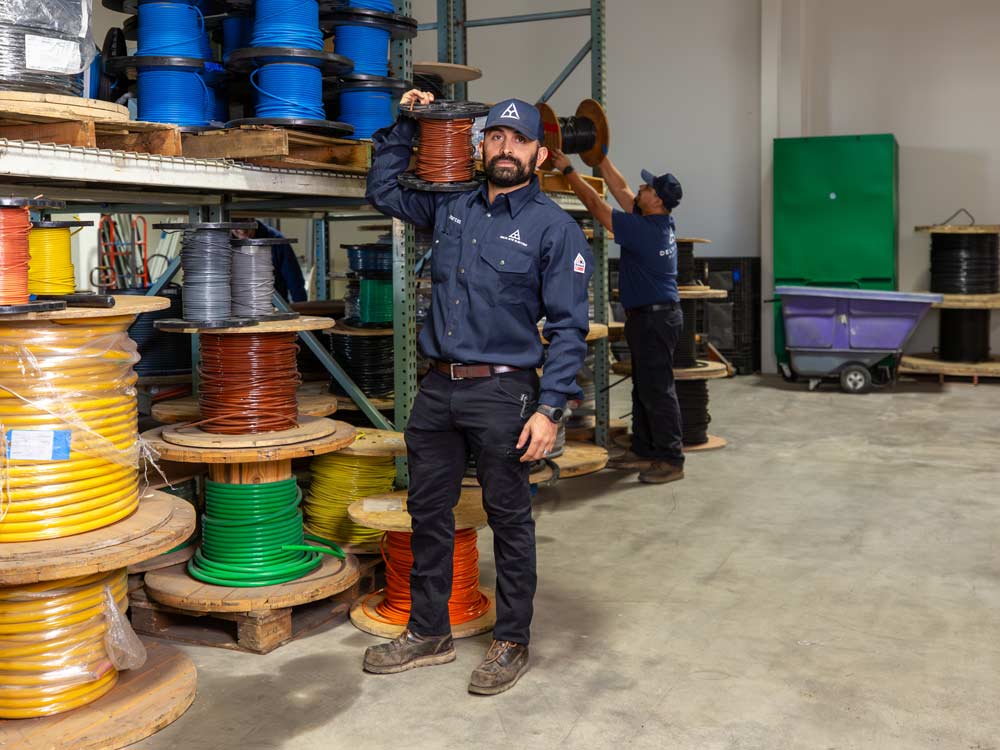In our ever-evolving technological landscape, one innovation that has proven exceedingly valuable in electrical maintenance is an infrared electrical inspection. Rooted in advanced thermal imaging technology, this type of inspection has made it possible to identify potential hazards and issues in electrical systems before they become significant problems. This article explores infrared electrical inspection and how it is an unseen guardian of electrical systems.
Making Sense of Modern Electrical Systems: Complexity, Potential Faults, and Their Impact
Modern electrical equipment and systems are intricate networks composed of numerous components working in tandem to ensure a smooth and efficient flow of electricity. These systems power our homes, offices, manufacturing plants, and critical facilities that facilitate our day-to-day functioning.
However, these systems are far from infallible. Over time and given the relentless demand placed upon them, they are susceptible to several potential abnormalities or faults. This could range from overloaded circuits, flawed insulators, and loose connections to corrosion of components. Understanding these systems’ complexity is the first step in recognizing potential issues.
One minute electrical fault in part of the system can create a ripple of disruptions, significantly impacting the efficiency and safety of the whole. Unchecked electrical faults can result in heightened energy costs, electrical fires, equipment damage, and far more severe consequences in extreme cases. Given these potential risks and the implicit nature of these problems, it becomes crucial to have a reliable and efficient method to keep check on our electrical systems—this is where the role of infrared electrical inspections gains paramount importance.
A Closer Look at Infrared Electrical Inspection Services
Infrared electrical inspection, or thermographic inspection, is centered around detecting and visualizing heat. The way this works is incredibly fascinating. Every object emits some form of infrared radiation, which is heat energy. Unique cameras designed for these IR thermography inspections capture this radiation and translate it into electrical signals, which are then processed to form a thermal image or thermogram.
In an electrical context, issues like overloading, corrosion, or poor connections can lead to an abnormal heat pattern. These abnormalities become vividly apparent in the thermograms, allowing technicians to spot problems at their nascent stage.
The power of infrared technology lies in its non-invasive, non-contact nature. An infrared thermography inspection can be performed while systems are under average load, avoiding unnecessary downtimes. Also, this method is swift, making it possible to inspect a large number of connections and components in a relatively short amount of time. These advantages make infrared scanning an ideal choice for monitoring the health of electrical systems.
The Infrared Electrical Inspection: Detecting the Unseen
The beauty of infrared electrical inspections is how they illuminate the unseen, casting light on issues that may have otherwise gone undetected until a component failure or a costly system breakdown occurred.
Consider, for instance, an overloaded circuit. To the naked eye, everything might seem normal. However, if inspected using infrared technology, the overloaded component would appear visibly hotter than the other thermogram components. The same applies to corroded connections or poor insulation. These issues can go unnoticed for an extended period during routine visual inspections. Still, with an infrared scan, they appear clear as day.
Similarly, electrical panels are under constant scrutiny for potential fire hazards in large industrial settings. Often, the problem starts at a microscopic level with a single loose connection heating up. Inspections using infrared technology can spot this hot spot effortlessly, allowing the problem to be fixed before it escalates to a full-blown catastrophe.
These examples underscore the value of infrared electrical inspections in bringing unseen potential issues to light, acting as a preventive measure and a guardian of our vital electrical systems.
The Preventive Role of an Electrical Infrared Inspection
Infrared electrical thermography inspections are pivotal in preventive electrical equipment maintenance strategies. They serve as a proactive approach that uncovers potential faults before they evolve into substantial, often expensive, issues. Let’s delve into the multitude of ways these inspections play a preventive role:
- Early Detection of Problems: Due to the sensitivity of infrared cameras, they can spot minor temperature discrepancies. Potential faults, such as loose electrical connections, overloading, or insulation defects, can be identified and rectified before they escalate into more significant issues.
- Prevention of Unexpected Breakdowns: Regular infrared inspections can help prevent unexpected machinery or system breakdowns. By uncovering the ‘hot spots,’ technicians can perform targeted maintenance, reducing the incidence of equipment failure.
- Avoiding Electrical Safety Hazards: Electrical faults can lead to significant safety hazards, including electrical fires. Infrared inspections can detect overheating components that pose a fire risk, enabling remedial action to be taken promptly.
Invariably, these preventive measures significantly impact the lifespan and reliability of electrical systems:
- Increased Equipment Lifespan: By catching problems early, the strain on electrical components is lessened, lessening wear and tear and thereby increasing the lifespan of the equipment.
- Improved System Efficiency: A well-maintained and regularly inspected system runs more efficiently. This means less energy consumption and reduced utility bills.
- Enhanced System Reliability: A regular IR inspection improves the overall reliability of an electrical system. With breakdowns and failures minimized the chance of unexpected downtime is significantly reduced, ensuring smooth operations.
These inspections allow us to nip potential electrical problems in the bud while ensuring our systems remain efficient, safe, and reliable for longer. Thus, infrared electrical inspections truly stand as an unseen guardian of electrical systems.
Incorporating Infrared Electrical Testing into Regular Maintenance
Embracing infrared electrical inspections as part of your system’s preventive maintenance can be of enormous value for small and large establishments. Here’s how to start incorporating this powerful tool into your maintenance routine:
- Establish a Regular Inspection Schedule: The frequency of the inspections generally depends on the size and nature of your operations. Monthly or quarterly reviews might be necessary for large industrial plants or facilities with critical electrical loads. Annual or bi-annual inspections suffice in smaller processes or less critical systems.
- Engage Certified Professionals: It is critical to engage with certified thermographers who are well-versed in the technology and skilled in interpreting thermographic images. This guarantees accurate results and ensures proper safety measures are taken during the process. At Delta Wye Electric, we have in-house technicians readily available.
- Maintain Inspection Records: Keeping a detailed record of each inspection is critical. Note areas checked, abnormalities detected, actions taken, etc. This log becomes a valuable resource to track issues longitudinally, gauge the effectiveness of your preventive maintenance strategy, and provide historical references for future inspections.
- Prioritize High-Risk Areas: Some parts of your electrical system are more vulnerable or critical to your operation than others. These could include distribution boards, overloaded circuits, or old electrical machinery that’s been in use for many years. Prioritize these areas in your inspections.
- Take Corrective Actions Promptly: An inspection that reveals a fault is only beneficial if corrective actions are implemented promptly. Ensure there’s a system in place to repair or replace problematic components immediately after they’re identified.
- Infrared Inspection as a Regular Process: Regularly promote the importance of these inspections to all stakeholders to ensure that it’s accepted as a regular part of your facility maintenance.
- Training and Awareness: Conduct regular training and awareness sessions for your team. This improves understanding of the process and assures better cooperation and efficiency.
By taking these steps, you can responsibly incorporate infrared electrical inspections into your regular maintenance routine, considerably enhancing your ability to maintain and manage your electrical systems effectively and safely.
Don’t let electrical faults catch you off guard and lead to costly downtime! Reach out to Delta Wye Electric today for comprehensive infrared scanning services.
Our seasoned professionals are ready to collaborate with you to determine the most critical areas for inspection, deploy our certified infrared technicians, and deliver an in-depth analysis complete with actionable recommendations. With our guidance, you’ll be empowered to implement tailored preventative maintenance solutions that protect your operations and bottom line.
Contact Delta Wye Electric now, and ensure your electrical systems perform safely and optimally. Secure peace of mind with our expert infrared scanning support.
Final Thoughts on Electrical Infrared Testing
In conclusion, infrared electrical inspection is the unseen guardian of electrical systems. Its ability to identify potential issues before they grow into substantial problems proves to be an indispensable tool in promoting system efficiency, safety, and longevity.
Considering its multiple benefits, from economic advantages to safety assurances, regular infrared electrical inspections should be part of any comprehensive maintenance regimen. We strongly encourage all businesses, large and small, to consider this a worthy investment in their electrical systems’ smooth, efficient, and safe operation. Be proactive, prioritize regular infrared electrical inspections, and see the difference it makes in your electrical system management.
Get in touch with Delta Wye Electric immediately to guarantee the safe and optimal performance of your electrical systems.
Frequently Asked Questions About Infrared Testing of Electrical Equipment
1. How often should infrared inspections be done in a facility
The frequency depends on the type and size of the facility, as well as the load on the electrical systems. However, many organizations benefit from a 6-12 month inspection cycle.
2. How long does an infrared electrical inspection take?
The duration of the inspection depends on the facility’s size and complexity. A few hours to a few days is typical, but extensive facilities may require more time.
3. How much does an infrared electrical inspection cost?
The cost depends on several factors, such as the size of the facility, the complexity of the systems, and the location. Generally, professionals charge an hourly rate ranging from $200 to $400 per hour. For specifics, getting a quote from a local service provider or industrial electrical contractor is recommended.
4. What is the best infrared camera for electrical inspections?
The choice of camera depends on specific needs and budget. However, some popular options include the FLIR E8, FLIR E6, and the FLUKE Ti100. These cameras are praised for their image resolution, accuracy, and ease of use, but it’s advised to do your research or seek expert advice based on your unique requirements.
5. Can infrared testing detect all types of faults?
While infrared inspections are extremely useful in detecting many types of faults that cause temperature variations, they won’t catch every kind of electrical issue. Therefore, they should form a part of an overall comprehensive preventive maintenance strategy alongside other types of inspections and tests.









